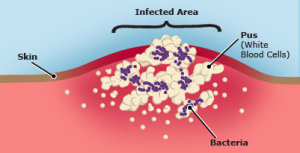 Infected wounds occur when microorganisms colonize within a cut or puncture wound, causing either a deterioration of the wound or delayed healing. Most wounds are contaminated with some amount of bacteria. However, infections result when the body’s immune defenses are unable to cope with bacterial growth. The skin contains bacteria (normal flora) which is normally harmless if the skin is intact. If the protective barrier formed by the skin is disrupted by a wound, these normal flora are able to take over the injured area. The most common bacteria causing wound infection is Staphylococcus aureus and other groups of staphylococci. Contamination from other parts of the body may also cause wound infection. Poor wound dressing techniques and unhygienic conditions may increase the risk for wound infection.
Infected wounds occur when microorganisms colonize within a cut or puncture wound, causing either a deterioration of the wound or delayed healing. Most wounds are contaminated with some amount of bacteria. However, infections result when the body’s immune defenses are unable to cope with bacterial growth. The skin contains bacteria (normal flora) which is normally harmless if the skin is intact. If the protective barrier formed by the skin is disrupted by a wound, these normal flora are able to take over the injured area. The most common bacteria causing wound infection is Staphylococcus aureus and other groups of staphylococci. Contamination from other parts of the body may also cause wound infection. Poor wound dressing techniques and unhygienic conditions may increase the risk for wound infection.
Common causes for infected wounds include:
- Bites – Wound infections due to bites tend to reflect the microorganisms present in the saliva and oral cavity of the animal that created it.
-
Trauma – Trauma is a wide category of injuries caused by physical force. It includes everything from burns to injuries from motor vehicle accidents, crushing injuries, cuts from knives and other sharp instruments, and gunshot wounds.
- Post surgical – Surgical sites are most commonly infected with the person’s normal skin and/or gastrointestinal flora – the same organisms seen with superficial infections. They may also become infected by exposure to microorganisms in the hospital environment.
- Burns – Burns may be caused by scalding or flammable liquids, fires and other sources of heat, chemicals, sunlight, or electricity.
Signs of an infected wound:
As wounds are healing, there are often some distinct changes that occur to the skin both around and near the wound. While this wound healing is nothing to be embarrassed about – your body is properly caring for itself – there are some warning symptoms to keep watch for. Here are a few things that you can expect – and the things to watch out for:
Fluid
Normal: This is one of the ways our bodies naturally heal themselves. Drainage can either be clear or slightly yellow in color.
Not Normal: If you notice green, yellow or cloudy drainage seeping from your surgical site, this could be a sign that your wound is infected.
Redness
Normal: A small amount of redness and inflammation around the tissue that has been altered.
Not Normal: Any redness the spreads into splotches or thready, spider web-like patterns beyond the wound could be a sign of infection.
Raised Skin
Normal: Most surgical procedures produce some type of scar, which is completely normal. Scars are a result of the body healing itself by pulling the skin beside the wound in to close the incision site. Because of this, you will often get raised skin directly on the wound, as well as tighter skin on both sides of the surgical area.
Not Normal: When a wound is infected, the lymph nodes closest to the surgery site will often become enlarged. As a matter of precaution, it is good to feel these nodes from time to time to make sure that an infection is not going unseen and untreated.
Other common signs include:
- An unpleasant odor coming from the wound
- Generalized chills or a fever
- Excessive swelling or increasing redness around the wound
- Increasing tenderness or throbbing of the wound
- Swelling lymph nodes in your neck, groin, or armpit
- Red streaks within the skin progressing away from the wound
- Pus or drainage
- Warmth near or on the wound
Treatment of Infected wounds:
Treatment will depend on how severe the wound is, its location, and whether other areas are affected. It may also depend on your health and the length of time you have had the wound.
- Wound cleaning may be done with soap and water to wash away germs and decrease the risk for infection. Your doctor may cut open a part of the affected area to clean it better. The wound may be rinsed with sterile water. Germ-killing solutions may also be used. Objects, dirt, or dead tissue from the wound will be removed with debridement (surgical cleaning). Wet bandages may be placed inside the wound and left to dry. Other wet or dry dressings may also be used. Your caregiver may also drain the wound to clean out pus.
- Antibiotics help fight or prevent an infection caused by bacteria.
- NSAIDs help decrease swelling and pain or fever. This medicine is available with or without a doctor’s order.
If you are concerned about possible wound infection contact your local Coastal Urgent Care and speak with one of our doctors today.
